
The Navy Department Library
Lookout Manual 1943
NavPers 170069
PDF Version [5.8MB]
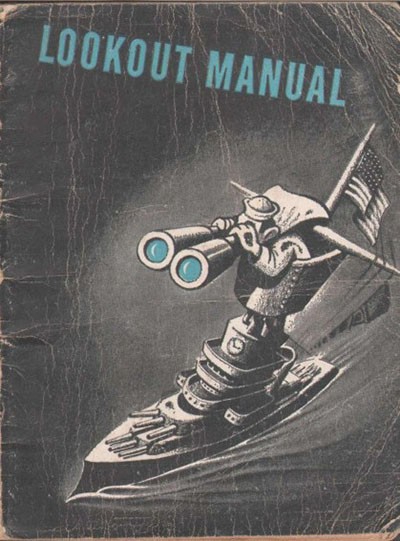
Copies of this booklet may be obtained by requesting from any Training Aids Library or from the Chief of Naval Personnel. NavPers 170069. [Note: This publication is no longer available in hardcopy from the Navy.]
[signature at top of page - L. B. Clegg]
LOOKOUT MANUAL
by the Bureau of Naval Personnel
CONTENTS
| Section 1 | Importance of Lookouts | 3 |
| Section 2 | Physical Qualifications of Lookouts | 5 |
| Vision, Hearing, Fatigue | ||
| Section 3 | Lookout Positions | 7 |
| Horizon, Surface, Sky, Fog | ||
| Section 4 | What a Lookout Must Know | 13 |
| How to Report: Phone Equipment, Contact Report, Ampli- | ||
| fying Report, Acknowledging Reports, Rules for Reporting | ||
| Section 5 | What to Report | 17 |
| Relative Bearings, Target Angles, Distance, Position Angle | ||
| Sect1on 6 | Equipment for Lookouts and Its Use | 25 |
| Care and Use of Binoculars, Alidade, Pelorus, Position | ||
| Angle Indicator, Gogqles, Dark-Adaptation Gogqles, | ||
| Clothing | ||
| Section 7 | Proper Methods of Search | 31 |
| Scanning, Sky Lookouts - Scanning, Cloudless Sky, | ||
| Partly Cloudy, Low Overcast, High Overcast, Surface | ||
| Lookouts | ||
| Section 8 | Night Vision Technique | 35 |
| How to Use Your Eyes at Night, How to Search at Night, | ||
| Dark Adapting Your Eyes, When to Put on Dark-Adapta- | ||
| tion Goggles, Protecting Dark-Adaptation with Red Light, | ||
| Hints on Spotting Ships at Night, General Rules for Seeing | ||
| at Night | ||
| Section 9 | Identification of Ships and Aircraft | 41 |
| Section 10 | Spotting Submarines | 43 |
| Periscopes, Torpedoes | ||
| Conclusion | 48 |
NavPers 170069
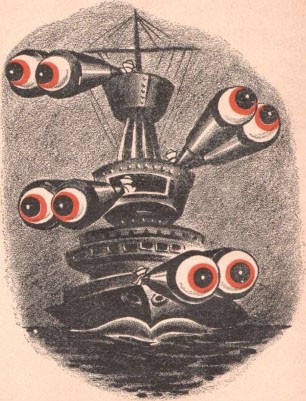
section 1
Importance of Lookouts
A lookout is the "eyes" of his ship. As a lookout you are charged with a heavy responsibility, which includes that of seeing and reporting any enemy ship or plane before he can attack, and of sighting and reporting any menace to navigation before your ship enters the danger area.
Your job is to sight objects, not only before anyone else in the ship, but also in time for all hands to man battle stations before an attack develops, or for any other action that may be necessary. Your ability to sight and report the enemy before he can attack may enable your ship to win an engagement with enemy surface craft, sink an enemy submarine, or shoot down attacking planes. On the other hand, inattention to your lookout duties, or carelessness in performing them, may easily cause the loss of the ship and the death of your shipmates.
Your reports, properly made, may be a vital factor in bringing victory to, or saving your ship. Never lose sight of your responsibility - of your importance to your ship.
To serve both the offensive and defensive purposes above suggested, you must have the "know how" involved in carrying out your duties properly. Getting the "know how" is the primary purpose of Lookout Training.
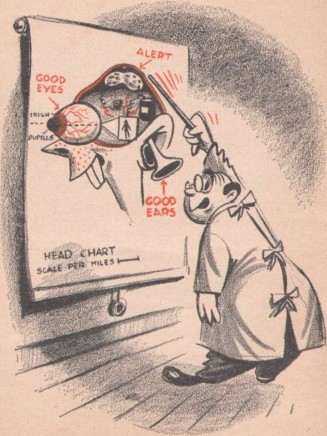
section 2
Physical Qualifications of Lookouts
VISION. The first and fundamental physical qualification of a lookout is good day and night vision. The ability to sight objects during daytime, and at night depends portly upon training, and portly upon good vision. You must hove both to qualify as a competent lookout.

HEARING. Satisfactory hearing is a requirement.
When visibility is at a minimum, as during a heavy fog, keen hearing is tremendously important. Men posted as fog lookouts con of ten hear sounds from other ships, buoys, etc., before they con see them. Training in recognizing significant sounds at sea is important.

ENDURANCE. Keep in good physical shape! A tired lookout is an invitation to trouble for the whole ship. Fatigue is sure to interfere with your night vision. You owe it to your ship to be at your best.

[5]
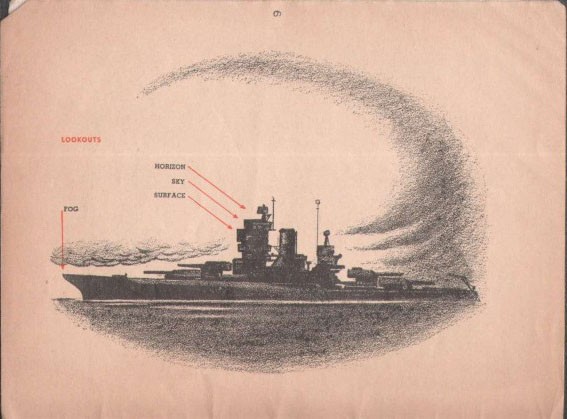
section 3
Lookout Positions
Lookouts are classified as follows:
1. Horizon lookouts are stationed high to obtain maximum range of vision.
2. Surface lookouts are stationed in a well-protected location as low in the ship as is physically possible and as the condition of the sea permits, from which they can see the surface of the sea.
3. Sky lookouts are stationed where they can best see the whole sky.
In small craft the available men may have to combine the duties of two kinds of lookouts, or even of all three. All lookouts - in fact, all hands on board ship - report everything they see, wherever it may be located. Even the most harmless appearing object might be hiding a periscope.
HORIZON LOOKOUTS. The horizon lookout is so named because his first duty is to detect objects near or beyond the horizon before they are visible from lower positions in the ship.
On all ships it is essential that the horizon lookout have the highest position practicable - for any part of the ship that extends above his position may be sighted by an enemy before the enemy becomes visible to him .
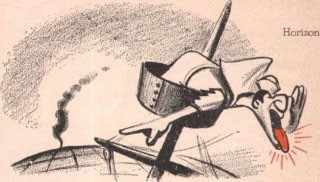
SURFACE LOOKOUTS. Surface lookouts are so named because their attention is concentrated on the surface of the sea. They must report everything within view, from the ship to their horizon, and they must be able to detect and recognize a great variety of objects, such as periscopes, torpedo wakes, mines, ships of all types, buoys - even whales. They are stationed as low in the ship as practicable in order to obtain the advantage of seeing an object silhouetted against a lighter sky background above a near horizon. This is especially true at night.
Surface lookouts must search the sea rapidly and with extreme thoroughness, because periscopes, mines, and torpedo wakes may first be sighted close aboard.
SKY LOOKOUTS. Sky lookouts are so named because they are responsible for the entire bowl of the sky, from the horizon to directly overhead. They report everything sighted including friendly and enemy planes, flares, blimps, parachutes, rockets, and even shooting stars.
The sky lookout's job makes severe demands on the eyes. Sky lookouts should search intently for brief periods and then be relieved. For this reason they should be organized in pairs, one searching and the other reading position angle and bearing, or acting as a talker.
No matter what type of ship you are serving in - no matter what your lookout duties are, never forget that:
WHEN YOU HAVE PICKED UP A TARGET DIFFICULT TO SPOT, MAKE YOUR REPORT, BUT DO NOT TAKE YOUR EYES OFF IT UNTIL YOU
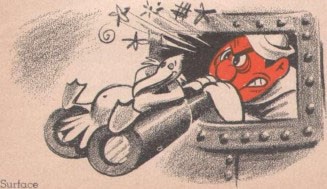
[9]
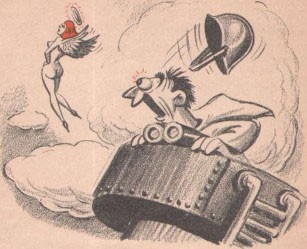
KNOW IT HAS BEEN SEEN BY PROPER AUTHORITIES. HOWEVER, AS SOON AS YOUR REPORT OF A PLAINLY VISIBLE TARGET IS ACKNOWLEDGED, RESUME SEARCH OF YOUR SECTOR FOR NEW TARGETS.
The enemy is tricky. Sometimes he will try to sneak in his main attack, gambling that you will have your attention on a target already under fire. Don't let him get away with it! Cover your area thoroughly at all times - even in the midst of action - and don't be distracted by anything, or you will be playing right into his hands.
FOG LOOKOUTS. When a ship is running through fog, it is in an extremely blind condition, and danger from mines and collision is greatest. Fogs vary considerably in thickness. Visibility may be only a few hundred yards, or even zero. It often happens that a fog thins, or even lifts above the surface of the water. This enables lookouts stationed very low in the ship to see much farther than lookouts stationed higher. One or two fog lookouts are normally stationed at the bow. They can see farther ahead than the bridge watch, and also are better placed to hear other ships and thus help prevent collision. For this reason, they report all that is heard as well as all that is seen. On the other hand, if there is a low, dense fog, it is practical to place a lookout as high as possible; he can thus see farther than would be possible at the bow.
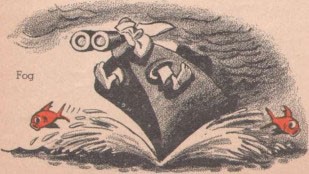
[11]
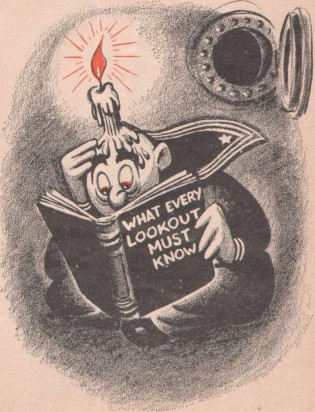
section 4
What Every Lookout Must Know
A skillful lookout spots and identifies objects on the sea and in the air during all conditions of light and weather. He also relays immediately the necessary information to the proper place. Just sighting an object is of no use unless it is called to the attention of those responsible for bringing it under fire, or avoiding torpedoes or bombs.
Lookouts should be able to
Report properly.
Estimate relative bearing of target.
Estimate "target angle."
Estimate "position angle."
Estimate approximate ranges of objects.
Search effectively during daylight and at night.
Identify ships and aircraft with which his ship may come in contact.
HOW TO REPORT. The officers in your ship depend on the reports that you make to them when you are on watch as a lookout to help them meet any situation the ship may encounter.
PHONE EQUIPMENT. The entire efficiency of the lookout system depends on speed in getting proper reports to the right officers. Lookout stations are connected with Control Stations by telephone. Adequate communication must always be maintained.
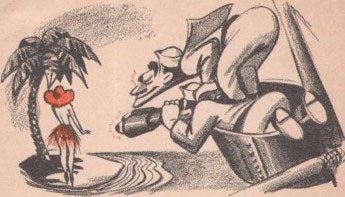
THE CONTACT REPORT. It is essential that every object sighted be reported to the proper authority immediately This first, speedy report is called the contact report. This report gives two essential facts:
1. What you see.
2. Where you see it.
"What you see" is the shortest possible name of the object you have sighted. Destroyer! Smoke! Cruiser! Plane! Submarine! Mine! Battleship! Slick! Buoy! Periscope! Object!
When you can't make out something you have sighted, report it merely as on object, and at the close of the report, say this: "Cannot make it out." In
Making Contact Reports, Never Hesitate While You Try to Identify the Object You Have Sighted.
Report it immediately, giving it its proper name if possible, and if not, calling it an object. By putting the phrase "cannot make it out" at the end of the contact report, you will avoid delay in giving your officers the information essential to proper action.
"Where you see it," is the relative bearing and estimated distance of the object you are reporting, as:
"Bearing zero-seven-zero, half way to the horizon."
In contact reports of planes, position angle is included, and is given after the bearing, often in place of range, as:
"Bearing one-one-oh! Position angle, 10 degrees!"
Make your contact report in the fewest possible words and in the shortest possible time! "What you see," and "Where you see it." Properly done, this will give your officers the information they require in from 2 to 6 seconds from the time you have sighted an object.
THE AMPLIFYING REPORT. After the contact report has been made, in order to give the officers more complete information, a second report, the amplifying report, is made. This report normally gives five items of information:
1. Station called.
2. Station reporting.
3. What you see.
4. Where you see it.
5. What it is doing.
The first and second items simply call the report to the attention of the officer concerned, and tells him who is reporting. The third item tells what has been sighted. The fourth and fifth items describe its location, and tell what is happening.
ACKNOWLEDGING REPORTS. Be sure that your reports are acknowledged. Only when you hear the proper acknowledgment, can you be certain that your report has been received. If the report was to Bridge, the Bridge Talker should acknowledge, "Bridge, Aye, Aye." If to Conn, the Conn Talker says: "Conn, Aye, Aye"; or to Air Defense Officer: "Air Defense, Aye, Aye." If your report is not acknowledged, repeat it. The station called may not get your report for various reasons. For example, it is possible that phones are being shifted or are even out of commission. After repeating your report a second time and still receiving no acknowledgment, make your report to another station in the vicinity of the station called. Request that the information be relayed. Get Your Reports Through!
REPORTING
Follow these rules:
1. Give your report in a clear, distinct voice.
2. Be sure your reports are acknowledged.
3. Use as few words as possible - what you see; where you see it.
4. Give relative bearings and target angles in regular Navy style.
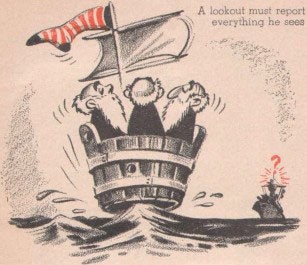
section 5
What to Report
RELATIVE BEARINGS. Definition. - The relative bearing of an object is the direction of the object measured from the ship's heading. The ship is assumed to be on course 000. The relative bearing is the angle between the ship's course and a line to the object measured clockwise from the bow, in degrees. The horizon - the point where the sky and water seem to
![[top] Figure I showing 3 circles indicating bearing circles marked at 000, 045, 090, 135, 180, 225, 270, 315. [bottom] Figure II showing 1 circle indicating the distance between each number is 30 degrees. [top] Figure I showing 3 circles indicating bearing circles marked at 000, 045, 090, 135, 180, 225, 270, 315. [bottom] Figure II showing 1 circle indicating the distance between each number is 30 degrees.](/content/history/nhhc/research/library/online-reading-room/title-list-alphabetically/l/lookout-manual-1943/_jcr_content/body/image_11549561.img.jpg/1465563865446.jpg)
meet - forms a vast circle. Every circle, regardless of size, measures 360 degrees around. (See Figure I. - Bearing circles marked at 000, 045, 090, 135, 180, 225, 270, 315.
Observe that 000 is always ahead and that the degrees are always counted clockwise - that is, in the same direction as the hands of a clock move. It may be helpful to consider the bearing circle as the face of a clock. The distance between each number is 30 degrees (Figure II).
You must give the relative bearing in approved Navy style. All relative bearings are reported by the use of three numbers.
Examples as follow:
| Written | Spoken |
| 005 | zero - zero - five |
| 045 | zero - four - five |
| 180 | one - eight - oh |
| 300 | three - double - oh |
| 207 | two - oh -seven |
| 030 | zero - three -Zero |
IMPORTANCE OF PRACTICE. Learn the bearing circle and then practice taking relative bearings on everything you see. If, for example, you and your shipmate are making a liberty and spot a couple of blondes on the beach, take a bearing on them. Don't say that there are a couple of blondes over there, but rather, "Two blondes, bearing 045!" Constant practice will help you to be quick and accurate when it counts.
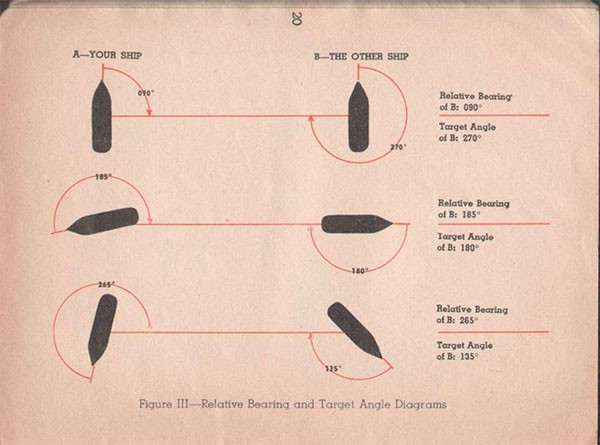
[20]
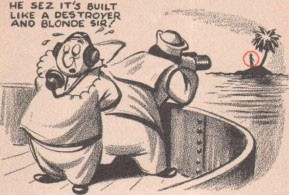
TARGET ANGLES. After some experience, lookouts should learn to estimate target angles. This information is of great value to the OOD, and much valuable time can be saved if lookouts can proficiently estimate this angle. The purpose of reporting target angles is to tell the Officer of the Deck the approximate course of the ship sighted. Don't let the title fool you! Target angles are reported on all ships - friend or foe.
Target angle is measured clockwise from the course of the target to the line of sight of your own ship. In other words, Target Angle is the relative bearing of your ship as seen from the target. Target angles are reported in degrees.
See Figure III for examples.
DISTANCE. A knowledge of how to estimate ranges is
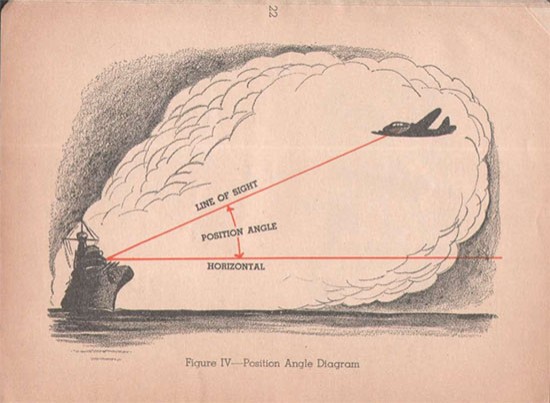
essential. Range is usually reported in units of miles or yards. However, the distance of an object relative to the horizon, such as "one quarter of the distance to the horizon," "half the distance to the horizon," etc., or "close aboard," or "hull down," are all descriptive of the distance of an object. The latter method can be more readily learned and eliminates a considerable amount of guesswork. Tables and curves are available to assist you in estimating the ranges of objects visible from different heights. Study them and apply your knowledge at any and every opportunity in order to develop your ability in estimating ranges. Estimate ranges whenever you get a chance, and compare your estimates with the actual range whenever possible. You can thus develop real ability to judge range accurately.
POSITION ANGLE. As a sky lookout, it is your duty to search an assigned sector of the sky, and to report everything sighted in it to the proper stations. In order to do this effectively you must give more than just a relative bearing of a sighted plane. You must also report the position angle.
The lookout's line of sight is aimed above the horizon, making a vertical angle with it. This angle is known as the position angle, since it gives the exact position of the plane above the horizon. (See figure IV.)
You can describe the vertical location of a plane by reporting the position angle in degrees. The point
directly overhead is the zenith. The zenith is position angle 90 degrees. Position angle is always measured from that portion of the horizon nearest the plane. Thus, no position angle will ever exceed 90 degrees. When a plane has passed overhead, its position angle is measured from the portion of the horizon which you see directly below it; once it passes the zenith it is no longer measured from that part of the horizon from which it came.
As the plane approaches from the horizon at constant speed and altitude, the position angle increases very slowly until the plane reaches a position angle of about 25 degrees. Then the position angle increases more and more rapidly. A plane flying toward you at constant speed and altitude seems to rise quickly. Actually, it does not rise, but only appears to, due to the increase in position angle.
The plane must be spotted and reported while it is still some distance from the ship, sine it takes a battery several seconds to get into action, and since it also takes time for shells to reach the plane.
Experience has shown that a modern bomber must be spotted before it reaches a position angle of about 25 degrees, if the plane is to be shot down or forced to turn away before it reaches the release point of 55 degrees. After this it is too late to stop the plane from dropping its bombs. Sighting, reporting, shooting, and hitting must be completed before the bombs are released.
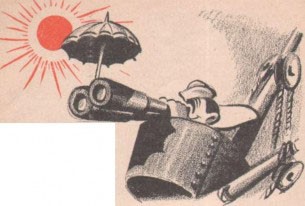
section 6
Equipment for Lookouts and Its Use
CARE AND USE OF BINOCULARS. Binoculars are fragile gadgets - they get out of whack when handled roughly or carelessly. Take care of them - the day will come when you will need badly all the help they can give you. They cost a lot of money, and they are scarce, as not enough can be made to equip all those who should have them.
Follow these suggestions:
1. Always use the neck strap.
2. Hold the binoculars against your chest when you lean over.
3. Don't let them strike against anything.
4. Don't leave binoculars in the sun.
5. Keep the binoculars in the case when not in use.
6. Don't expose binoculars to sudden, extreme changes in temperature.
7. Keep your binoculars clean.
(a) Use lens tissue. If available, use lens cleaning liquid according to directions.
(b) Don't use your sleeve or anything that contains grit or grease.
(c) Don't blow on the lenses in below-freezing weather - the moisture will make a skating rink and you won't be able to see.
Most binoculars have two adjustments, the inter-pupillary adjustment and the eyepiece adjustment. Bend the binoculars so that the eyepieces are the same distance apart as the pupils of your eyes. If this adjustment is not properly made you will see something like this [two overlapping circles]; when made correctly you have a single visual field and it appears like this [a single circle]. Practice making this adjustment several times and when you are sure you have done it correctly - note the number on the hinge, and always remember it! It is a good idea to have the medical officer measure the distance be-
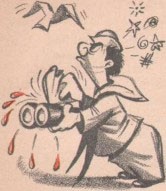
tween the pupils of your eyes, to ensure a correct adjustment.
The second adjustment is on each eyepiece. Start with the setting at +4. Close one eye and turn the eyepiece until the object you are observing is clear and distinct. Note the number that gives you this adjustment. Then do the same for the other eye. Remember these numbers! Because our day and night eyes differ, this focusing has to be done both for daylight and for the dark. Most likely your night focus will be one to one and a half minus from your day focus.
It is most important that you remember both adjustments. You won't have time when going on watch to experiment and find the proper settings.
When using binoculars hold them against your eyebrows. At night look at the bottom of the binocular field - it is a fact that you can see better that way! Use your binoculars for night scanning! See pages 35, 36, and 37.
It may be that at some time you will be forced to use binoculars that are out of collimation. This means that the two barrels and the hinge are not absolutely
parallel, as they are supposed to be. An expert optical repairman can fix them but - don't you monkey around! However, even binoculars that are not properly collimated are not entirely useless. Make your regular adjustments, but turn the binoculars so that you use just one eye - like a telescope.
By taking good care of your binoculars and using them correctly you can guard your life and the lives of your shipmates.
ALIDADE. Binoculars for surface lookouts are usually mounted on an alidade, which indicates bearings in degrees. Horizontal motion of the binoculars is transferred through a shaft to a bearing indicator below. A dial follows the horizontal movement of the binoculars, and gives in degrees the exact bearing angle.
To take bearings at night, a red light provides a dim illumination.
PELORUS. On some ships the lookout may use a pelorus to take bearings. The pelorus has two sighting vanes on opposite sides of a pivot. These sighting vanes are lined up with the object observed, and the bearing is read through a slot in the arm carrying the vanes.
Warning on Night Use of Pelorus:
1. Do not permit light in pelorus to show brightly.
2. Always turn off when not in use.
3. Never turn on when in area of possible enemy aircraft.
POSITION ANGLE INDICATOR. The elevation (position angle) of an approaching airplane is measured with a position angle indicator which may be attached to the binoculars. It consists of a ball that rolls in a curved path, and indicates the angle of the binoculars to the horizon. When the glasses are pointed horizontally - at the horizon - the ball is at rest at zero degrees. As the binoculars are raised above the horizon, the ball rolls back and indicates the angle. The relief lookout reads the position angle, while the lookout keeps the approaching plane centered in the field.
Sky lookouts may have special supports secured to the deck and arranged to permit search through binoculars from the horizon to a position angle of 40 degrees. The type of support may vary from vessel to vessel. For the additional sweep to the zenith, the naked eye is used.
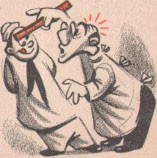
GOGGLES. To protect lookouts' eyes from wind and weather and to adjust the intensity of light reflected from the water and from sunlit clouds, lookouts use goggles. They are light green, ground and polished. Since it is difficult to use both goggles and binoculars, binoculars are fitted with easily removable filters of the same color as the goggles.
A type of goggle used by some lookouts is the variable density polaroid goggle. The lookout can adjust them to admit a comfortable amount of light, regardless of the brightness of the part of the sky he is searching. By adjusting the goggles to their greatest degree of density he can search the area around the sun with perfect ease. However, goggles should never be adjusted "too dark" as the range of visibility of objects would be decreased.
DARK-ADAPTATION GOGGLES. Put on dark adaptation goggles at least 30 minutes before going on watch. If possible avoid exposing your eyes to any white light, by putting goggles on immediately upon being awakened. They adapt your eyes to darkness even while you wear them in a room with bright white lights. While you are on night duty, if it is necessary for you to look at anything under a white light, or Visit a lighted room such as the chartroom, always put your dark adaptation goggles on first.
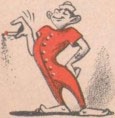
CLOTHING. Lookouts are often exposed to bad weather. For this reason, you are provided with especially designed clothing and equipment, which give extra protection. Be sure to dress warmly at all times, as it will help keep your efficiency as a lookout at a maximum.
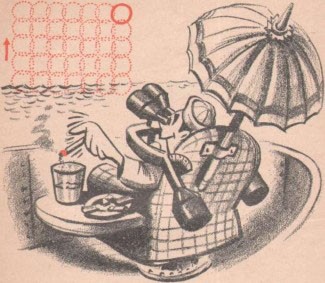
section 7
Proper Methods of Search
SCANNING. If you are going to be a good lookout, you need more than a good pair of eyes, a good pair of binoculars, and a place from which you can look. You must also know how to look!
Did you ever watch a person's eyes while he was reading? If so, you observed that the eyes moved in jerks. That is the way you scan your sector when
standing lookout watch. Our eyes see better using this method.
It is important that you search your assigned area according to some system. Things happen too fast to use a hit-or-miss method - you get hit, and miss the enemy. Don't sweep the horizon! Use a step-by-step method. Start at the extreme left or right of your sector, move your binoculars 5 degrees into the sector, pause for about a second, move another 5 degrees, pause again. Continue until you have completed your sector. Then sweep back to the starting point and proceed as before. By using this method you cover your search area thoroughly and quickly.
At night, look at the bottom of the binocular field and search in a slow continuous sweep. Remember this in connection with pages 25, 26, and 27.
SKY LOOKOUTS - SCANNING. All lookouts use the step-by-step method of search, but the sky lookout must
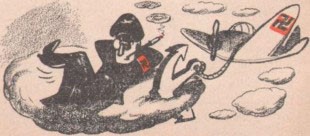
apply it somewhat differently, since he must search vertically as well as horizontally, and his methods of search depend on cloud conditions. The method laid out below is based on the fact that a good lookout can sight planes at 6,000 yards with his naked eye, and at two or three times that range with binoculars.
The eye is much quicker and covers a much larger field than binoculars. It should be used unaided whenever and wherever, because of cloud conditions, planes can only be sighted within the range of visibility of the naked eye. Thus, if the sky is overcast at 2,000 feet, planes will be readily sighted with the naked eye at position angles over 6 degrees and binoculars should not be used above this angle. On the other hand in a cloudless sky the sweep with the binoculars must be extended up to 30 degrees position angle in order to ensure sighting planes flying at high altitude.
CLOUDLESS SKY. 1. Sweep arc of 0 degree to 30 degrees position angle in your sector with your binoculars by successively increasing position angle in 5-degree steps. After each complete sweep drop your binoculars and rest your eyes briefly by sweeping higher position angles with the naked eye.
2. On cloudless days your eyes will tend to lose distant focus, and may focus on a point a short distance away. When this occurs it will be most difficult to pick up a plane in clear sight. Remember this and occasionally glance at clouds, distant ships, objects, etc., to refocus your eyes.
PARTLY CLOUDY. 1. Search 0-degree to 30-degree arc with binoculars as before; then sweep edges of clouds up to about 50 degrees. 2. As clouds increase in number operate as for overcast conditions.
LOW OVERCAST. 1. Sweep your sector with binoculars for 3 degrees of position angle for every 1,000 feet height of overcast. Thus, for overcast at 3,000 feet sweep with binoculars only to 9 degrees or 10 degrees. Maintain sharp watch with the naked eyes up to 50 degrees position angle.
HIGH OVERCAST. 1. Use the procedure for low overcast up to height of clouds of 10,000 feet. Above that use procedure for cloudless day.
SURFACE LOOKOUTS. The surface lookout uses the step-by-step method of search in practically the same way as it is used by the horizon lookout. However, as a surface lookout, you must search the entire surface of the sea from very near your ship to the horizon.
Search the entire surface by moving your binoculars in a horizontal path, pausing each 5 degrees. This step-by-step method of search gives your eyes a chance to detect any object which does not fit into the whole picture. You will soon become accustomed to using this search pattern, and you will find that with it you can cover a wide area in a short time.
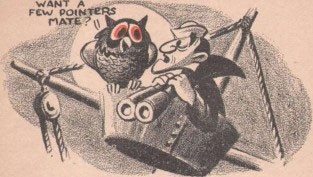
section 8
Night Vision Technique
HOW TO USE YOUR EYES AT NIGHT. The business of being a lookout requires that you learn two methods of seeing which are quite different. Daylight searching uses the step-by-step method. In this method, the eyes are focused in a series of brief steps on certain areas or objects.
For night searching you must learn a brand new method which may seem strange at first.
HOW TO SEARCH AT NIGHT. When you look directly at the horizon on black nights, the horizon immediately in front of your eyes is actually not seen. Any object lying in this region will escape detection. This fact is very little appreciated by civilians, but it is
one of the most important facts to on expert lookout searching at night.
The recommended technique of night scanning consists of the following: The lookout directs his eyes at levels about 10 degrees above or below the horizon. He does not sweep his eyes evenly over the area for which he is responsible, but moves them in short jumps of about 10 degrees to 15 degrees, with momentary fixation pauses, to search the sky or horizon systematically and to be alert for objects in the "corners of the eyes." This may involve slight movements of the head as well as movements of the eyes. The lookout should be cautioned to direct his vision in quick jumps with short fixation pauses, and not keep staring at any one place for a long period of time. Nothing can be seen while the eyes are actually in motion, but they are most sensitive just after being moved. When an object is suspected in a particular area the lookout should "scan" this area, moving his eyes in short jumps from 10 degrees on the right side of the object, to 10 degrees above, to 10 degrees on the left side - until more complete identification is made. This technique does not come naturally to most people, and therefore must be prac-
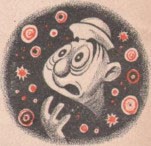
ticed conscientiously. Your "night eyes" are sensitive to very dim light, but they are even more sensitive to motion. Therefore, your night eyes detect moving objects much more readily than they detect stationary ones.
As you know, when using binoculars in the daytime, you look straight through them. But when using binoculars on dark nights, a different method is necessary. Hold them up to your eyes, but direct your gaze downward, below the binocular field. You will find that you can see more clearly this way, because of the peculiar characteristics of night vision.
DARK ADAPTING YOUR EYES. If you were to go on night watch direct from a lighted compartment, you would find that you would be almost blind for a few minutes. Gradually your vision would improve as your eyes become accustomed to weak light. After 10 minutes, you would be able to see fairly well. It would take 30 minutes, however, before you would reach your best night vision. This improvement of vision in dim light is adaptation to darkness, usually called dark adaptation.
An improved method of adapting your eyes to darkness is to wear special red goggles for half an hour prior to going on watch. They adapt your eyes to darkness while you wear them.
The goggles with which the Navy supplies you are especially designed for dark adaptation. While wear-
ing them under ordinary white light, you can play games, write letters, or read almost as comfortably as you could without them.
Although you have worn dark-adaptation goggles half an hour before going on watch, it still takes at least 5 minutes more in darkness before you have developed your best night vision. Therefore, never relieve the watch until you have actually been at your station in actual darkness for at least 5 minutes. This is in addition to the 30 minute period during which dark-adaptation goggles are worn.
WHEN TO PUT ON DARK-ADAPTATION GOGGLES. When you are awakened for a night watch, put on your dark-adaptation goggles immediately, even before you open your eyes. This prevents your eyes from losing the adaptation to darkness which they have acquired while they were closed during sleep. If it is necessary for you to visit a lighted compartment, or look at anything under any but red light, always put on your dark-adaptation goggles first.
PROTECTING DARK ADAPTATION WITH RED LIGHT. Quartermasters have to make numerous entries in their notebooks during night watch. If these entries must be made on the bridge the light from a flashlight with a red lens will give sufficient illumination. Never use a white light, for it will destroy your dark adaptation. Of course no one should ever use any
flashlight - red or white - in such a way that the enemy could glimpse its direct light, or even its light reflected from some object.
HINTS ON SPOTTING SHIPS AT NIGHT. As a good lookout, you must know how enemy ships are apt to disclose themselves. For example, when the moon is either rising or setting, a ship which happens to cross between you and the moon will be silhouetted for a short time. In much the same way, a ship passing between you and coastal lights may disclose itself by blocking out a portion of them.
Watch reflections of the moon or a bright star. A ship crossing the path of reflected light will appear as a dark object which interrupts the normal motion of the light reflected from the waves.
On a night "so black that you cannot see your hand in front of your face," it is still possible to detect ships by the phosphorescence they stir up. Phosphorescence is often very prominent in the bow wave, in the wash alongside the ship, and in the wake. Very often, single flashes of light may be caused by a distant ship striking a patch of very bright phosphorescence.
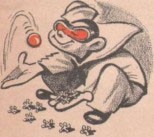
Under certain conditions a distant fog bank or a low lying bank of clouds may appear lighter than the water or sky. When this occurs, a ship may be silhouetted against it.
Under different conditions, a ship may pick up enough light from stars or moon to appear as a light object against a very dark background. You will see such ships only when the moon or bright stars are in back of you, since only at this time will enough light strike the side of the ship visible to you.
GENERAL RULES FOR SEEING AT NIGHT. The experienced lookout knows how to use the brain as well as the eyes. As a lookout, your value to your ship will depend on remembering and using the following important rules:
1. Be dark adapted before assuming duties as lookout at night.
2. Use red light only at night.
3. Wear your dark-adaptation goggles when entering a lighted compartment at night.
4. When dark adapted, avoid all light other than red.
5. Keep optical equipment clean.
6. Know your eyepiece settings and interpupillary distance, for properly setting and focusing binoculars.
7. Search assigned area using night search method of off-center vision.
8. Keep in good physical condition. Fatigue is sure to interfere with your night vision.
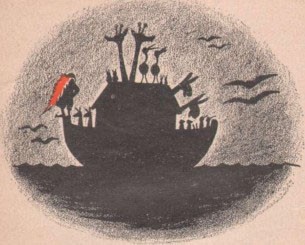
section 9
Identification of Ships and Aircraft
The identification of ships and aircraft deals with the different types, classes, and structures. To be able to identify a ship means to be able, first, to tell whether or not it is a ship - as distinguished from other visible objects such as islands, rocks, or trees or buildings
ashore; second, to be able to tell what type of ship it is - whether it is a battleship, a cruiser, a destroyer, some type of auxiliary vessel, etc.; third, to be able to tell whether it is a ship of our own fleet, that of an ally or that of the enemy; fourth, to be able to tell in which direction the ship is moving in relation to your own ship, or whether or not the ship is still - by considering certain features of that ship. The importance of this subject to the lookout cannot be stressed too highly, and much time and effort should be spent by all lookouts in studying the many pamphlets and training aids available on this subject. Identification material is not included in this manual in view of the excellent material already available.
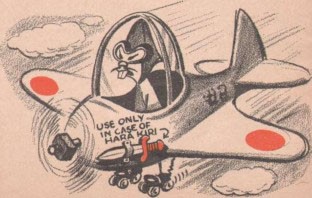
[42]
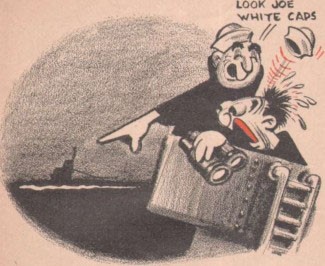
section 10
Spotting Submarines
The very nature of the submarine makes it difficult to detect, and makes its attacks extremely deadly. The submarine has a long, low, and narrow hull. The conning tower, which is the navigating bridge when the submarine is surfaced, is the only prominent structure above the hull.
PERISCOPES. A modern attack periscope is no larger than a swab handle, and need be exposed no more than a few inches in calm seas. It is normally raised only when the submarine is traveling at very low speed, when the periscope will leave almost no wake. When the submarine is making sufficient speed the periscope causes a very noticeable wake, or streak of foam, which is called a feather because of its white and featherlike appearance.
The attack periscope is so difficult to spot that the lookout must be extremely alert to see it.
Submarines may have an armament of one or two guns of moderate size - from 3 to 6 inches - usually located on the deck, forward or abaft the conning tower. In addition to these guns, one or more antiaircraft machine guns may be mounted. Many foreign submarines have their guns mounted on a forward extension of the conning tower, well above the deck.
If you sight what looks like a small boat bow-on, or stern-on, at a distance, look it over sharply, for it may be the conning tower of a submarine running awash. "Awash," of course, means that the submarine is running with its deck just below the surface while the conning tower projects above. German submarines generally operate at night while awash. By cruising this way, they are able to obtain air for diesel operation, and are in a position to make a crash dive.
A submarine making a periscope attack will expose its periscope for only about 10 seconds at a time. Every
suspected feather should be reported, even though it disappears immediately. When a periscope is moving to leeward, the telltale feather is quite likely to be absent or unnoticeable, since the periscope is moving with the waves. This makes it even more difficult to spot the submarine.
Many submarine attacks must be made on short notice. Therefore, they may come from any quarter. For this reason, you must always be alert to detect a periscope, whatever the direction of your search.
Submarine attacks are most likely to come in the bow sectors from 300 across the bow to 060. Lookouts cover assigned sectors irrespective of type of ship or nature of duty. These sectors on the bows of ships convoyed are the most vital.
On the surface the submarine is much less conspicuous than surface ships of comparable size. This is due, of course, to the low deck and small conning tower. When a submarine tends to blend with the water, a lookout in a low position often can see it silhouetted against the sky. Submarines often have been spotted
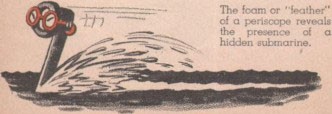
at night by members of the crew on deck. Remember this every time you go topside.
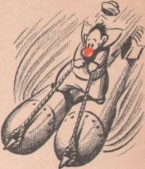
At night, submarines often lay to with their decks awash while charging batteries. If the sea is not too rough, they may cruise with the decks awash. In this condition, a submarine can make a crash dive in a matter of seconds. A submarine awash presents a very small target, and this makes a lookout's job still more difficult. When awash, a submarine often has a long streak of foam both forward and abaft the conning tower. On very dark nights, this foam may be more visible than the conning tower itself.
Submarines may sometimes reveal themselves by unintentional signs. One of these is oil slick, from a leak due to damage from depth charges, or from some other cause. Since small oil slicks break up rapidly in moderate seas, you must report instantly every slick in sight. Flocks of gulls may signal the presence of a submarine. They sometimes follow the faint shadow of the submarine in the same way they follow schools of small fish. Therefore, always report any unusual gathering of gulls.
A submerged submarine can identify itself to friendly ships by releasing a recognition signal which rises
quickly to the surface, where it ignites and gives off colored smoke. One type of signal, on breaking water, fires a smoke bomb 1 or 2 hundred feet into the air, where it explodes. Lookouts must be very prompt in reporting such recognition signals, and should report the color at once.
TORPEDOES. The underwater projectile of the submarine is the torpedo. Torpedoes, other than electric, form a wake or streak of foam on the surface, caused by gas bubbles released by the torpedo during its run. The torpedo may be set to travel at various speeds and depths. The speed varies, and may be as high as 50 knots. Since the gas bubbles rise to the surface slowly, a torpedo may be running more than a hundred yards ahead of the wake which appears on the surface. Since the torpedo runs so far ahead of its wake, the lookout has very few seconds to report a sighted wake if his ship is to maneuver to avoid the torpedo. Here, if ever, seconds count.
Even though you know how submarines may look under different conditions, spotting them is still your toughest job. You can never know too much about it.
You can search the sun's reflection for submarines by wearing goggles. Under these conditions of great light contrast, the submarine appears in silhouette. On moonlight nights, the path of the moon's reflection should be watched on the chance that a surfaced submarine may be spotted.
You may never see more than one or two submarines. When you do see one, or its periscope, or a periscope feather, the safety of your ship, as well as the chance to destroy a deadly enemy, will depend on its instant recognition.
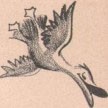
Conclusion
The hints contained in this manual can aid you to become more proficient in your job as a lookout. Read them frequently, studying them, and apply them whenever possible. Remember that your ability as a lookout may mean the difference between a major victory and a bitter defeat.
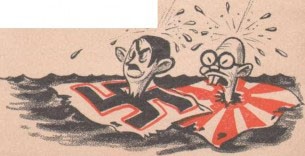
[48]
UNITED STATES
GOVERNMENT PRINTING OFFICE
WASHINGTON, 1943
16-37450-1
USN Bureau of Naval Personnel Training Aids



